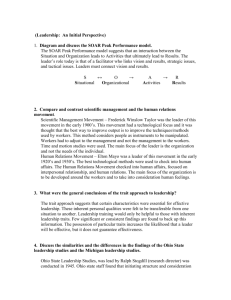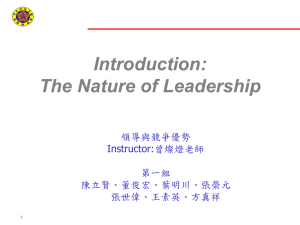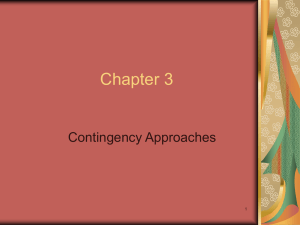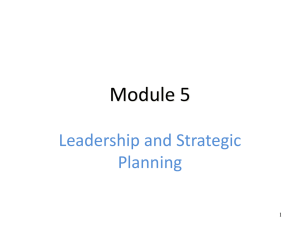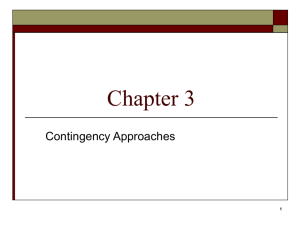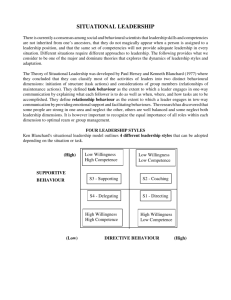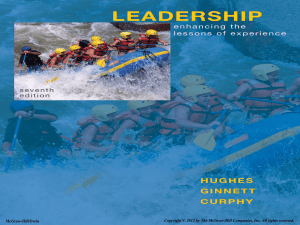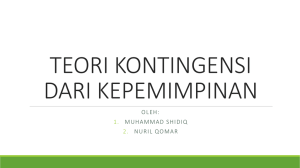Behaviour Theory of Leadership. Chapter 3 Behavioral theory
advertisement
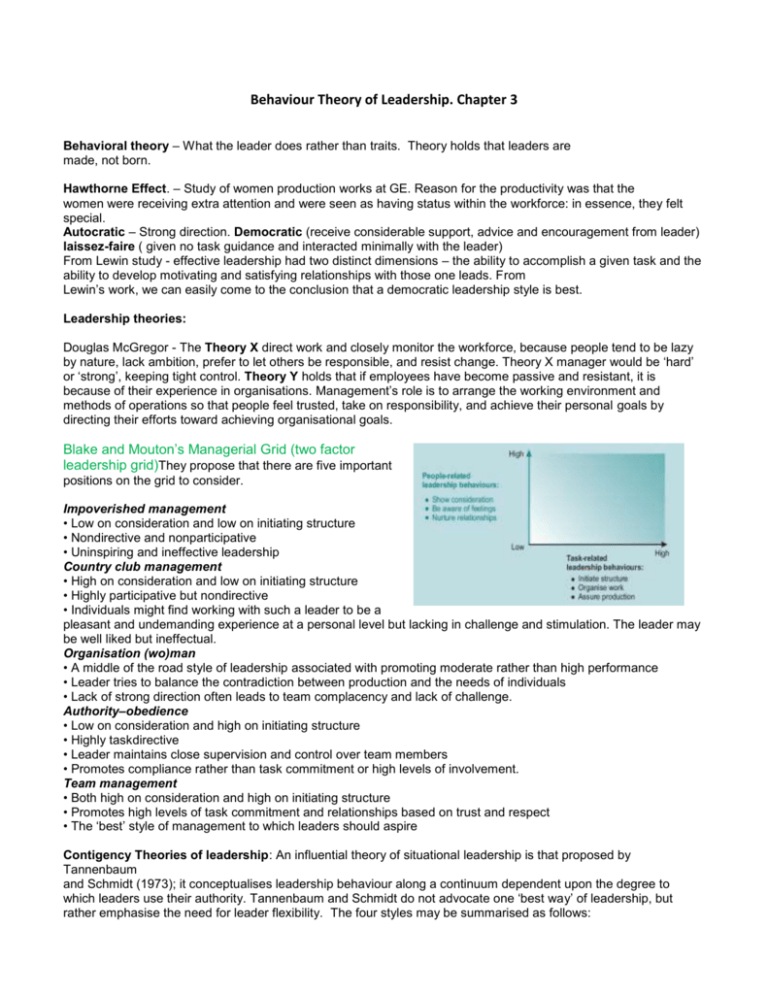
Behaviour Theory of Leadership. Chapter 3 Behavioral theory – What the leader does rather than traits. Theory holds that leaders are made, not born. Hawthorne Effect. – Study of women production works at GE. Reason for the productivity was that the women were receiving extra attention and were seen as having status within the workforce: in essence, they felt special. Autocratic – Strong direction. Democratic (receive considerable support, advice and encouragement from leader) laissez-faire ( given no task guidance and interacted minimally with the leader) From Lewin study - effective leadership had two distinct dimensions – the ability to accomplish a given task and the ability to develop motivating and satisfying relationships with those one leads. From Lewin’s work, we can easily come to the conclusion that a democratic leadership style is best. Leadership theories: Douglas McGregor - The Theory X direct work and closely monitor the workforce, because people tend to be lazy by nature, lack ambition, prefer to let others be responsible, and resist change. Theory X manager would be ‘hard’ or ‘strong’, keeping tight control. Theory Y holds that if employees have become passive and resistant, it is because of their experience in organisations. Management’s role is to arrange the working environment and methods of operations so that people feel trusted, take on responsibility, and achieve their personal goals by directing their efforts toward achieving organisational goals. Blake and Mouton’s Managerial Grid (two factor leadership grid)They propose that there are five important positions on the grid to consider. Impoverished management • Low on consideration and low on initiating structure • Nondirective and nonparticipative • Uninspiring and ineffective leadership Country club management • High on consideration and low on initiating structure • Highly participative but nondirective • Individuals might find working with such a leader to be a pleasant and undemanding experience at a personal level but lacking in challenge and stimulation. The leader may be well liked but ineffectual. Organisation (wo)man • A middle of the road style of leadership associated with promoting moderate rather than high performance • Leader tries to balance the contradiction between production and the needs of individuals • Lack of strong direction often leads to team complacency and lack of challenge. Authority–obedience • Low on consideration and high on initiating structure • Highly taskdirective • Leader maintains close supervision and control over team members • Promotes compliance rather than task commitment or high levels of involvement. Team management • Both high on consideration and high on initiating structure • Promotes high levels of task commitment and relationships based on trust and respect • The ‘best’ style of management to which leaders should aspire Contigency Theories of leadership: An influential theory of situational leadership is that proposed by Tannenbaum and Schmidt (1973); it conceptualises leadership behaviour along a continuum dependent upon the degree to which leaders use their authority. Tannenbaum and Schmidt do not advocate one ‘best way’ of leadership, but rather emphasise the need for leader flexibility. The four styles may be summarised as follows: Tells. This is an authoritarian style. The role of those they lead is simply to follow these instructions. This style is based on the assumption that followers have no useful role to play in decisionmaking, possibly because of lack of ability, knowledge or motivation. • Sells. A ‘selling’ style is little different from a ‘telling’ style, except that instructions and directions are articulated in a softer and more persuasive way. Leaders still take control and make decisions. The use of persuasion represents an attempt to try and secure willing compliance rather than simply impose the decision. • Consults. Leaders consult with followers and obtain their views. These views are taken into account, but leaders reserve the right to make the final decision, which may or may not be in line with the views of others. • Joins. This is a totally participative style. Leaders join with followers to make a decision in which all views are represented. Situational Leadership: A very popular development of the contingency approach to leadership is Hersey and Blanchard’s (1988) model of situational leadership, which rests on similar basic assumptions There is no single allpurpose leadership style, but rather what is appropriate depends upon the nature of the follower(s) and the demands and requirements of the task. • The leader’s behaviour has two independent components: directive behaviour and supportive behaviour. Directive behaviourrelates to the extent to which the leader provides structure and guidance concerning the task. Supportive behaviour relates to the extent to which the leader supports and acts with consideration towards followers. The model emphasises four leadership styles dependent upon one major situational factor, the developmental level of the follower for any given task.( three factors: having the technical knowledge, skills or competence to execute the task; the level of commitment to pursue the task; and the level of confidence that he or she will be successful at the task.) The four leadership styles that are to be matched with the respective follower development levels are: • S1 Telling (or directing). the follower is judged to need clear direction. • S2 Selling (or coaching). follower’s requires both direction and support. • S3 Participating (or supporting). follower is considered to have adequate mastery of the skills required for the job, but some support is required. • S4 Delegating. This follower will have mastered the task, has confidence, and so requires only that the task be delegated with little requirement for supervision. Fielders’s contingency model: Fiedler developed a measure called the least preferred coworker (LPC) scale. Leaders who attain a high LPC score are considered to have high selfesteem needs and so derive considerable satisfaction from interpersonal relationships. They will expend a lot of energy in providing support and consideration to improve relationships in situations where relationships are poor. In contrast, leaders with low LPC scores are considered to have high task accomplishment needs and so derive considerable satisfaction from task performance and achieving objectives. their primary motivation will be to focus on task accomplishment. theory suggests that effective leadership behaviour is dependent upon both the favourability of the situation and the degree of situational control. Rather the situation itself should be changed to fit the leader, or the leader should be assigned to situations that best fit his or her style. • Leadermember relations (good/poor): The degree to which a leader is trusted and liked by group members, and their willingness to support the leader and follow his/her guidance, the group atmosphere. • Task structure (high/low): The extent to which the task is clearly defined for the group, and the extent to which it can be carried out by detailed instructions or standard procedures. Highly structured tasks give the leader more control, whereas nebulous tasks diminish the leader’s control. • Position power: The amount of power and influence the leader has in the organisation, including the ability to give out rewards and punishments. If the leader can hire and fire, he or she has considerable position power. PATH GOAL Theory - It is influenced by theories of motivation, particularly what is termed expectancy– valence theory. The path–goal theory of leadership maintains that a leader should exercise the style of leadership that is most effective in influencing employees’ perceptions of the goals they need to achieve and the path (or way) in which they should be achieved. This is, in contrast to the situational approach, which indicates that the leader should adapt to the development level of the follower, as well as to the contingency approach, which emphasises matching the leadership style with situational variables. House identified four main types of leadership behaviour: • directive – giving clear instructions as to what the goal is and the way they should go about accomplishing it; • supportive – encouraging and supporting individuals in accomplishing the goal; • participative – involving individuals in the goalsetting process, and listening to their opinions and views; • achievement oriented – setting challenging goals, and building confidence in followers to achieve those goals. An advantage of path–goal theory is that it is uncomplicated and relatively straightforward. criticism of path–goal theory is that it is only partially supported by research conducted to support its validity. another concern is that path–goal theory may focus too heavily on the actions of the leader at the expense of the followers. With such an approach, followers could become overly dependent on the leader at the expense of their own development. Summary - some theorists suggest that the style should be determined by the follower’s development level (situational leadership), while other theorists submit that leadership style is probably fixed and therefore the leader should be assigned to a situation where he or she can be most successful (contingency theory). Yet another behaviour theory school of thought is that an analysis of the follower’s goal orientation combined with the relative clarity of the task will determine the most effective leadership approach (path–goal theory). Learning Summary Behavioral leadership theory contrasts with trait theory in that it studies leaders’ behaviors, what they do, rather than their personal characteristics. Behavior theory holds that leaders are made, and therefore leadership effectiveness can be learned by developing and employing appropriate skills and behaviors. Early research identified two key dimensions of leadership behavior, a focus on achieving the task at hand and a focus on developing the relationship with the follower. Douglas McGregor (Theory X–Theory Y) developed the idea that leaders would tend to focus either on task or on relationship, but that to focus on one dimension would be at the expense of the other. Blake and Mouton submitted that a strong leadership focus on both the task and the relationship was the ‘best’ style of leadership. Contingency theory emerged in the 1970s and considers what kind of leadership style would be effective in what kind of situation. Hersey and Blanchard’s situational leadership model became the most widely used model of behavioral theory, which diagnoses the follower’s task development level before selecting the most appropriate leadership behaviors. The contingency model (Fiedler) proposed that leadership styles are relatively fixed, being effective in certain situations but less so in others. So leaders should be placed in situations where they will likely achieve success. Path–goal theory marries leadership theory with motivational theory so that the motivational needs of the follower are considered along with the work situation in selecting an effective leadership approach. Behavioral leadership theory is intuitively appealing, as most leaders will attribute much of their success to developmental experiences, and it also supports the idea that organizational time and resources should be placed against the development of its leadership capability.

